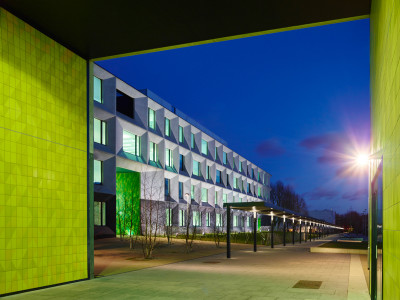The month in architecture
The month in architecture
Everything you need to know that happened in October
By Helena Cuss
Published 1 November 2015
The biggest architecture news, the weirdest new projects and the latest prizes – rounded up into one handy post each month.
-
Hilla Becher dies
The German artist and photographer, Hilla Becher, has died aged 81. She and her husband, Bernd, emerged in the 1960s, introducing a new type of architectural photography. Their typological series of industrial structures and buildings such as water towers, gas cylinders, silos and blast furnaces were photographed with large-format cameras in stark black and white with a purely objective aesthetic. They worked not only in their native Germany, but also in the United Kingdom, Belgium, Luxembourg, Holland and the USA. Bernd died in 2007. Read a full obituary by the Guardian.
Balfron Tower gets listing upgrade
The Balfron Tower, a renowned example of surviving Brutalist residential architecture in London, has been given a new listing of Grade II* to match its sister, the Trellick Tower, which was awarded the status in 1998. Designed by the architect Ernö Goldfinger and built in 1967, the distinctive 26-storey tower in east London has been the subject of much discussion and controversy in recent weeks. The architects Studio Egret West and Ab Rogers Design are seeking to refurbish and reconfigure large portions of the building, which preservation organisations such as the Twentieth Century Society and Docomomo feel would significantly harm Goldfinger’s distinctive aesthetic design. See proposals for the refurbishments on the Studio Egret West’s website.
Stirling Prize Winner announced
The architecture practice Allford Hall Monaghan Morris have won the 2015 RIBA Stirling Prize, with the Burntwood School in south London’s Wandsworth, for which they designed six new teaching blocks onto an existing 1950s campus. The buildings were praised by judges for being full of light and air with double-height spaces, for their beautifully framed views at the ends of corridors and for the inclusion of large colourful murals. They beat off competition from Richard Rogers’ luxury flats, Niall McLaughlin’s Peabody housing estate, MUMA’s redesign for Manchester’s Whitworth Gallery, a new building for the University of Greenwich by heneghan peng architects and Maggie’s Centre in Lanarkshire by Reiach and Hall Architects. Read more about the 2015 winners on the RIBA website.
-

Burntwood School

Big Ben

Naze Tower
-
More heritage building at risk
Historic England have added a number of surprising buildings to their Heritage at Risk list, including a former poison gas factory which in the early 20th-century employed 1,500 people – who were nicknamed canaries because the toxic chemicals stained their skin yellow. Also on the list are the 1968 concrete church of St Thomas More in Birmingham, designed by Richard Gilbert Scott, and the White Lion pub in London built in 1887, which rose to fame in the 1970s and 80s as a live punk music venue. The list has previously encouraged the funding to save Margate’s Dreamland funfair, built in 1919 which houses the oldest surviving rollercoaster in Britain, and the Naze Tower in Essex, a Grade II* listed lookout post built during the Napoleonic Wars. Peruse the At Risk register here.
Big Ben needs a £40m facelift
It has been revealed that the clock which crowns Big Ben, possibly the UK’s most iconic structure, is in serious danger of stopping altogether and possibly breaking beyond repair if it doesn’t get urgent repairs, which could cost the taxpayer up to £40m. According to a report presented to the Commons finance committee, there are “chronic” problems with the bearings behind the hands and pendulum in the clock itself, as well as “severe metal erosion, cracks in the roof and other structural defects” in the rest of the tower. The proposed refurbishment would see the clock stopping for 4 months (the longest shutdown in its history) and would cost at least £29m. Learn more about Big Ben on the Parliament website.
La Sagrada Familia enters final stages of construction
The construction of one of Spain’s most spectacular and famous buildings, the La Sagrada Familia Basilica, designed by Antoni Gaudi between 1883 and 1926, may finally reach completion 150 years after work began, and on the 100th anniversary of Gaudi’s death, in 2026. Once finished it will become the tallest cathedral building in Europe, with the Tower of Jesus Christ topping out at 172m. Three million visitors a year flock to Barcelona to see the fantastical, curving Art Nouveau designs melded to the Gothic stone exterior. Find out more about La Sagrada Familia on the official website.
-

La Sagrada Familia

La Sagrada Familia (interior)

La Sagrada Familia (interior)









